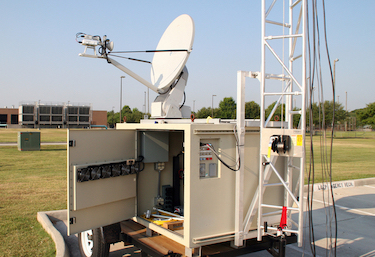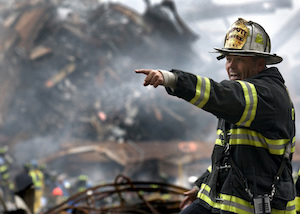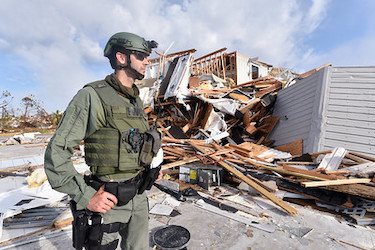Responding to Urban Disasters, Post Three (Post 7 of 14)
Responding to Urban Disasters, Post Three (Post 7 of 14)
Russell W. Glenn
The seventh of a series of blog posts on Urban Disasters: Readiness, Response, and Recovery by Russ Glenn.

Field Communications Unit; Hurricane Katrina/Hurricane Rita. Baton Rouge, LA, 24 May 2006. Public Domain, NARA & DVIDS Public Domain Archive.
This third of four posts regarding responses to urban disasters will extend our look at the role of command, leadership, and management. As with those previous, we begin with a list of key points so far noted.
Key Point #1: Preparation for any urban disaster helps to prepare an urban area for catastrophes regardless of cause or type.
Key Point #2: Urban disasters are more alike than different.
Key Point #3: Rehearsing/exercising plans—even in so simple a form as talking through challenges—is essential.
Key Point #4: Plans must be executable.
Key Point #5: No plan will survive contact with the disaster.
Key Point #6: Information is the currency of success
Key Point #7: Urban residents are key to successful disaster response. It follows that they are key to successful disaster preparation.
Key Point #8: The plagues of bureaucracy, poor delineation of responsibilities, and criminality are remoras on any disaster…except the relationship isn’t symbiotic.
Key Point #9: Look backward to look forward.
Key Point #10: Maintaining or improving post-disaster social infrastructure will often be harder than doing so for an urban area’s physical infrastructure.
Key Point #11: Plan for the end, then the now.
Key Point #12: What happens in urban areas doesn’t stay in urban areas…Las Vegas included.Key Point #13: Not all is what it seems in a city.
Supporting Key Point #13A: Don’t trust appearances.
Key Point #14: Expect the unexpected.
Key Point #15: Common sense sometimes isn’t common.
Key Point #16: Command, leadership, and management are fundamental to disaster response success.
Key Point #17: Getting the response structure right is vital.
Key Point #18: Leadership is important, but who should lead when?
Armed forces can be bulls in the proverbial china shop when it comes to their participation in urban disaster response. This take-charge attitude sometimes has its place. Military forces, designed and trained to deploy quickly, are frequently able to arrive quickly with a similarly responsive logistical system. Military personnel are trained to be flexible, able to adapt to a variety of situations even when those situations are highly dynamic. It is not unusual for their men and women to stay for extended durations after deploying, meaning they can possess a superior understanding of the disaster environment than other outsiders who stay for more limited stints (but, perhaps, not as deep an understanding as some nongovernmental or intergovernmental organization representatives with even more time in the locale). And the presumption that the military’s is inevitably an overly heavy hand doesn’t withstand objective scrutiny. Then Major General Darryl Williams leadership in West Africa during the 2014 Ebola crisis was commended for its cooperative and supportive character (though following US military leadership at times was more in keeping with the overly intrusive stereotype). Such willingness to be part of a larger team and not necessarily in charge can be necessary to the establishment of trust. That trust, in turn, underlies successful implementation of a mission command approach (whether called “mission command” or some other term is used to describe the oversight system in which clear guidance is given without dictating the details of how subordinates are to accomplish assigned tasks. See the third post in this series for a fuller description of mission command.). Mission command properly employed can be effective even when the organization in question is rigidly hierarchical. Its potential is even greater when the organization in question is a coalition or alliance of largely voluntary participants willing to work toward a common goal but less enthusiastic about being told how to do so.
Who should lead? Ideally it will be the organization most qualified. Ideally that will be the in-place government (be it local, state/provincial, or national). Hopefully an able one remains in the aftermath of the disaster. If not, the lead organization might vary over time as requirements evolve not unlike the transition of authority and responsibility during military amphibious operations. As with other aspects of disaster relief, so critical a matter should be planned for and subsequently red-teamed during rehearsals.
Key Point #19: Effective communications are essential to effective leadership.
Effective communications allow disaster response managers to orchestrate their resources much as a conductor leads an orchestra to create music instead of cacophony. Communications are complex, a complexity sometimes overlooked by those not intimately involved in a response. Yes, organizations’ leaders need to communicate with the subordinates and vice versa. But inter-organization communications are also vital, as is their nature. Communications between members of different organizations might be possible via direct contact regardless of the echelon if language and systems (e.g., phones, radios, or computers) are compatible. Often that is not the case. One of the tragedies associated with 9/11 in NYC was that New York City Police Department (NYPD)-New York City Fire Department (FDNY) communications were not nearly as effective as they could have been had equipment, procedures, and other factors been addressed before the event. The result: many fire personnel did not receive situation reports and evacuation warnings broadcast via NYPD channels. The result was many deaths that might have been avoided. Shortcomings were clear before 9/11. Fire and police department radios were found wanting during the response to the 1993 bombing of the World Trade Center (WTC). FDNY radios had not worked well within WTC towers. As was to prove the case again eight years later, police and fire cooperation had been less than desirable.[1]
Communications redundancy is hyper-important during urban crisis response. Communications systems may fail due to destruction of physical infrastructure, electromagnetic pulse, overburdening, or for other reasons. Having second, third, or even additional means of exchanging information can be vital. Preliminary planning and practice can help. Some emergency responders may be unable to reach their primary places of work due to disrupted public transportation, destroyed personal vehicles, flooding, debris, fires, or due to other causes. Primary report locations (where a responder should move to as designated in initial response plans, for example) will sometimes less need their services than do others elsewhere. Designating second and third alternate reporting locations before an event constitutes good planning. Being able to adjust those designations during a response because conditions render plans no longer applicable reflects the flexibility any good plan has built into it. But how to get word out that someone or some organization should report to their alternate or supplementary location? Establishing a sequence of communications means before a disaster is a great leap toward solution. As standing plans designate where individuals or organizations should report, no communication is generally necessary if responders are to proceed as designated. Communication is only needed when changes are called for. Plans can specify cell phones, landlines, radios, email, or other means as backups while also noting which type is to be employed in what sequence. Given that bandwidth or other limitations might make communication difficult, plans and rehearsals can also dictate ways to minimize the duration of messages. For example, a message might simply signal “2” to intended recipients, informing them that they are to report to their alternate location. Acknowledgment of message receipt could be “Ack” (for “Acknowledge”) or “2ack” to confirm the designated location as well.
Key Point #20: Data counts
The same databases that provided input during planning and rehearsals can be fine-tuned to address specific needs once calamity strikes. Census information, tax records, marketing survey results, those important property records: some, all, or others can feed the voracious appetite for information depending on the nature of the crisis, location, demographics, gaps in local capabilities, and aid provider resources. (The reason property records are so critical—and a reason insurgents or criminals deliberately target them for destruction—is that land ownership or lack of it proves a boon to any who can convince a government they own a plot or want to undermine a government by causing it to appear as the power stealing from rightful owners.) If patients have waived release of relevant medical information or local policies permit access regardless, medical data can tell aid providers who needs what treatment, medications, where someone lives, and what challenges exist (mobility limitations, deafness, asthma, need for insulin, reliance on home respirators, or psychiatric problems, for example). Pharmacy information provides less comprehensive but potentially still valuable insights. The potential to save lives begs the question of whether policies are in place to make such information available during a catastrophe; granting individual or collective permission to access the information before a crisis speeds response, especially if damage to an information infrastructure is such that attempting to collect it post-calamity denies access. Pre-disaster rehearsals and other exercises should point to additional information that health care providers could include as release-in-times-of-emergency data. Does the home respirator for a given patient have battery backup? If so, how long will the charge last? If not, does the residence have a backup generator? If so, how much fuel is stored at the location? What other type of battery or backup power source is on site? (Crankable? Rechargeable? None?)
We shouldn’t forget that disease can either be the primary cause of an urban disaster (plague in 17th-century Europe for example or, to a far lesser extent, COVID in 2020) or derivative thereof. During World War II, London’s Islington saw a 35 percent increase in pulmonary tuberculosis in 1943 as compared to the value five years before. The spike was 40 percent for non-pulmonary tuberculosis.[2]
The above are only some of the data that can help responders’ effectiveness thanks to their knowing what needs at-risk individuals have and where they live. If cellular systems are still operating (as well as the power infrastructure needed to recharge phones), cell phone data can be notably helpful given its real-time character. Emergency responders have used call time and cell tower locations data to track malaria outbreaks in Africa. They could similarly help trace the flow of commuters found to have been exposed to biological, radiological, or chemical contamination during a terrorist attack, accidental exposure, or chemical leak. Testing public sewage has already provided early warning of disease, another means of giving responders a headstart in detection and, potentially, interdicting spread.
Endnotes
[1] Louis Menand, “Disgraced: What happened to Rudy Giuliani?” The New Yorker, September 26, 2022: p. 75.
[2] Philip Ziegler, London at War: 1939-1945, New York: Alfred A. Knopf, 1995, p. 260.
The previous installation of this series “Responding to Urban Disasters, Post Two (Post 6 of 14),” appeared on 24 January 2023.


